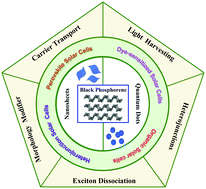A multifunctional 2D black phosphorene-based platform for improved photovoltaics
Abstract
As one of the latest additions to the 2D nanomaterials family, black phosphorene (BP, monolayer or few-layer black phosphorus) has gained much attention in various forms of solar cells. This is due largely to its intriguing semiconducting properties such as tunable direct bandgap (from 0.3 eV in the bulk to 2.0 eV in the monolayer), extremely high ambipolar carrier mobility, broad visible to infrared light absorption, etc. These appealing optoelectronic attributes make BP a multifunctional nanomaterial for use in solar cells via tailoring carrier dynamics, band energy alignment, and light harvesting, thereby promoting the rapid development of third-generation solar cells. Notably, in sharp contrast to the copious work on revealing the fundamental properties of BP, investigation into the utility of BP is comparatively less, particularly in the area of photovoltaics. Herein, we first identify and summarize an array of unique characteristics of BP that underpin its application in photovoltaics, aiming at providing inspiration to develop new designs and device architectures of photovoltaics. Subsequently, state-of-the-art synthetic routes (i.e., top-down and bottom-up) to scalable BP production that facilitates its applications in optoelectronic materials and devices are outlined. Afterward, recent advances in a diverse set of BP-incorporated solar cells, where BP may impart electron and/or hole extraction and transport, function as a light absorber, provide dielectric screening for enhancing exciton dissociation, and modify the morphology of photoabsorbers, are discussed, including organic solar cells, dye-sensitized solar cells, heterojunction solar cells and perovskite solar cells. Finally, the challenges and opportunities in this rapidly evolving field are presented.



 Please wait while we load your content...
Please wait while we load your content...
